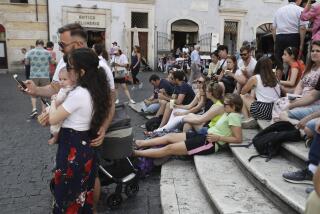Italy’s Instability Has Tourism Teetering : Mediterranean: Murder, arson, racism, terrorism, vandalism and corruption are cited.
- Share via
ROME — A baking sun still burns from cloudless skies, but Italy is already counting the costs of a long, dry summer in which greed, passion and intolerance have forged a national litany of human and natural destruction.
Murder, arson, racist violence, renascent political terrorism, vandalism against art treasures and the suicides of scandal-tarred industrialists all jostle for headlines.
Foreign tourists, normally easier to find in Rome in August than Italians, are again a fixture this summer. But their number has slumped alarmingly, with dire repercussions for Italians who live off tourism and for the national balance of payments, to which tourism is a major foreign exchange contributor.
An association of business people reported Tuesday that tourism has fallen 40% in a year, which could translate into the loss of more than $1 billion for restaurants and hotels alone. High prices, dirty cities and beaches, poor services and the threat of terrorism are keeping many visitors away. If the trend continues, the association warns, it could cost up to 40,000 jobs.
“Tourism demands an image, and Italy’s image is very faded,” said Battista Foderaro, president of Italy’s national hotel association.
It is also rather charred. The government last week ordered the army to help fight hundreds of forest fires that threaten to overwhelm firefighters and rangers in central Italy and on the islands of Sardinia and Sicily, where three firefighters died in one blaze on Mt. Etna.
More than half of the 10,000 rural fires that have occurred this summer are blamed on arsonists seeking to clear wooded land for cultivation or development.
Destruction is also reaching into Italy’s history and culture--the heart of its cities--and into its fields. In Puglia, in the heel of the Italian boot, right-wing hoodlums routed a settlement of African tomato pickers they blamed for an attack on a tramp.
On the high-toned Emerald Coast of Sardinia, a yacht full of joy-riding businessmen lopped the head off a much-loved natural rock sculpture known as The Turtle. Equally wealthy sunbathers sprang in outrage to their dinghies, surrounded the yacht, recovered the broken head and promise to restore it. The police are weighing charges against the vandals.
Police are busy too in search of the perpetrators of at least eight unsolved murders of young women, most of them apparent victims of sexually related crimes. In another murder, a mother beat to death her 18-year-old daughter out of jealousy over a shared 50-year-old boyfriend.
Crimes of passion share headlines with new pressures from an ever-growing corruption scandal and with a quickening search for political change that is stalked by violence.
On Tuesday, magistrates in Milan formally warned Sen. Marcello Stefanini, a senior official of the former Italian Communist Party, that he is under investigation for corruption in a kickback scandal.
Nearly a quarter of all Parliament members have been named in an 18-month-old investigation that has uncovered a longstanding web of bribery and corruption in which businessmen delivered kickbacks to politicians in exchange for public contracts.
In what appears to be a calculated response to the bribery investigation and the simultaneous drive by reformers to overturn a corrupt political system, terrorism has returned to Italian cities--possibly Mafia bombers in league with right-wing forces combatting the prospect of political change.
That, at least, is the official word from the chief of a national police force seeking bombers who have killed 10 people and wounded dozens since spring in attacks on some of the country’s most prized cultural treasures.
The Uffizi Gallery in Florence is partially open again after a car bomb there in May, but scars are unhealed at the basilica of St. John Lateran and San Giorgio in Velabro church in Rome and at Milan’s Gallery of Modern Art, all victims of bombs one night in July.
More to Read
Sign up for The Wild
We’ll help you find the best places to hike, bike and run, as well as the perfect silent spots for meditation and yoga.
You may occasionally receive promotional content from the Los Angeles Times.






